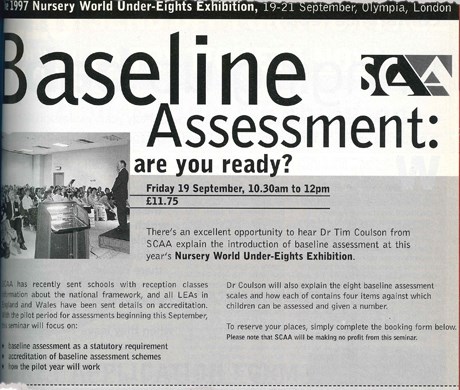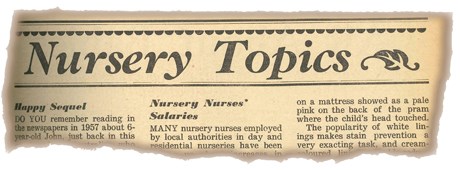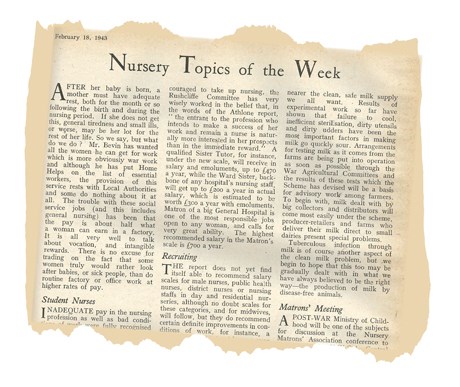Nursery World 90th anniversary: Over the Decades - Plus ça change?
Monday, December 14, 2015
While the past 90 years may have seen the demise of ‘lady nurses’, the Truby King method and woollen underwear, the same core issues crop up time and again, as Hannah Crown discovers

Any of the latest “big ideas” from the policymakers seem familiar? In 2005, Ofsted had just introduced no-notice inspections. A new tax exemption scheme for employer-supported childcare and children’s centres was being rolled out, and the Government’s ten-year strategy gave rise to the Childcare Act, which included a measure to extend free childcare for three- and four-year-olds to 15 hours per week by 2010. A decade later, and Nursery World is writing about how these initiatives have either been scrapped, reformed, reduced or extended.
Go a bit further back, to 1997, and we find an advert for Nursery World’s Under-Eights Exhibition where the new ‘baseline’ will be presented. Brought in by the Education Act 1997, it had eight baseline assessment scales for reading, maths, writing, speaking and listening, and personal and social development. Each contained four points against which children were assessed and given a number. It was abandoned in 2002, according to Cathy Nutbrown, ‘because it was an ineffective and damaging policy’. But now the pilot of the latest baseline is now underway and is for all children within six weeks of starting Reception, with three models testing at least communication and language, literacy and numeracy, and which require results to be condensed into a single non age-adjusted numerical score.

Aside from the legislative merry-go-round, when it comes to the core professional issues of childcare salaries, prestige, training and lack of male role models, well, they were talking about all this even in the early part of the century. In an excerpt from Nursery World, 18 February 1943: ‘Inadequate pay in the nursing profession [of which nursery nurses were then a part] as well as bad conditions of work were fully recognised in the Athlone report of 1938. As a result a Nurses’ Salaries Committee under Lord Rushcliffe was set up in 1941 and the scales of pay now recommended by them are a decided improvement on old conditions. The student nurse, for instance, for whom £20 in the first year of training was a quite usual salary, will receive twice this under Rushcliffe’s scale. As she gets her keep, sometimes uniform, and free treatment in sickness, the total value of salary and emoluments in the first year is estimated at £115 (£4,800 today), a sum which compares well with that received by office workers.’
In the 1980s, ‘Man about the House’, ‘Men as Carers’ and ‘Men Wanted’ were all fairly typical headlines
This came, of course, at a time that no one was expecting nursery work to be particularly well paid – after all, it was ‘Women’s work’ and women were not expected to receive the same salaries as men.
Twenty years later, in day nurseries, the words equal and pay appear adjacent in a sentence. The salaries for staff nursery nurses aged 20 and over that were formerly between £375 and £488 had been raised to £418 to £558 from January of that year and from January of the following year would be equal to men at £2 more respectively, equivalent to £8,800 to £11,650 today (from 28 January 1960).

With pay goes prestige, as this NNEB report on the future of nursery nursing noted, on 28 May 1981: ‘Although the evidence shows that nursery nurses as a group do an extremely good and valuable job in the different settings where they work with young children, it was clear that their skills and their contribution were constantly undervalued.’ Disgruntled NNEBs also complained. A letter from 26 February 1987 from M E Zgraja said, ‘Having worked in schools in? Waltham Forest for a number of years I feel both undermined and insulted that an unqualified person should be on a comparative salary. Nursery nurses working in education have no career structure, and are existing on an appallingly low income. When is our two-year training and subsequent NNEB certificate going to be considered of any worth?’
Later that year, on 8 October, a contributor asks: ‘So what is it that keeps the assistant in her lowly position? Attitudes instilled during training was one cause put forward by assistants. Society’s generally dismissive attitude towards carers of young children was a cause put forward by trainers. A more certain cause is that great difference in pay? An assistant starts at £4,803, while a teacher starts at £6,423. An assistant can never earn more than £5,880 [£15,407], while a teacher, even if she stays on the lowest scale, can get £9,804…’
When it comes to training, it is interesting to note the parallels with knowledge required of today’s nursery workers, as these questions from an NNEB exam of 1947 illustrate: ‘What is the importance of fresh air and exercise?’, ‘What are the essential points to remember in planning a day for a six-month-old, one-year-old and four-year-old?’ and ‘A three-year-old is crying because another has snatched his toy. How would you deal with this?’
The debate about whether qualifications are putting young people off from working with children isn’t new either, though it has had very different contexts over the years. ‘Nurse-training is still the most convenient means of providing essential medical background’ for a nursery worker, said the editor on 14 June 1956, but ‘the present lengthy training, up to four years three months, is likely to deter students, especially school leavers, who will probably become the main source of recruits, from taking up this work’.

Then we come to the role of men. ‘Painful doesn’t begin to describe the pace of progress. Less than 2 per cent of the childcare workforce is currently male. In 1997 just 1 per cent of the childcare workforce was. So, when Nursery World made its transition to a professional childcarers’ magazine in the 1980s, ‘Man about the House’, ‘Men as Carers’, and ‘Men Wanted’ were all fairly typical headlines. Prior to this, debate about the role of fathers was omnipresent in the letters pages. 0ne of the first mentions we can find of the idea of a ‘modern man’ taking an active interest in his child’s upbringing came on 16 November 1961: ‘No emancipation of women can take away the significance of a father in family life, in his dual role as provider for his little group and support for his wife. And this is no less true today when, in many cases, wives are part bread-winners? A Welfare State has made it possible for fathers to be home when the children are still awake, to play with them at the weekend, and to spend an annual holiday in their company. And on the whole, most fathers have gladly shared in these domestic pursuits. No longer do fathers wait for school-leaving age before they turn their attention to Bill’s future. From the time when he pushed Bill out for his Sunday morning walk, through successive stages of rough-and-tumble after tea, teaching him how to mend a fuse at six, and looking at his equations at 12, he has been getting to know his son as a person, founding a relationship which will outlast childhood.’
Discussions of inadequate pay appear several times over the years(18 February 1943, top, and 28 January 1960); advert for a talk on the baseline assessment (10 July 1997)
On 5 January 1984, Nursery World reported that a former insurance salesman had become one of the first male nursery nurses. ‘Robert McAleese, at the age of 31… took a deep breath and walked boldly across the hall of Thomas Danby College in Leeds. A good number of eyes followed him. Their owners had every reason to feel curious… He took his seat among the 119 women and resolved to stay the course. Two years later… [he] became a qualified nursery nurse, the first in Leeds and one of the few in Britain.’
Mr McAleese became interested in childcare from taking his children to playschool, received a grant to help with training fees, and having got his first job was promoted after just 21 months to deputy officer in charge.
A report from Claire Cameron of the Thomas Coram Research Unit identified obstacles to men working in childcare and was covered in Nursery World on 15 May 1997. Sadly many of these are still evident nearly 20 years later: female students tend to ‘mother male students or alternatively question their motivation, there is overt resistance to male students on some placements, students in family placements are vulnerable given the anxieties about both male students (commonly expressed by fathers) and female students (if alone with fathers) and limitations are imposed on male students on practice placements – for example, not being allowed to take children to the toilet unaccompanied or have any physical contact with children.
What other themes have endured? In the first year of the magazine, topics of discussion included breastfeeding, games and sports, dealing with teasing, indoor sand play, toddler care and putting the baby to sleep.
As the saying goes: plus ça change, plus ça reste la même chose. Or as Andre Gide put it, ‘Everything that needs to be said has already been said. But since no one was listening, everything must be said again.’




